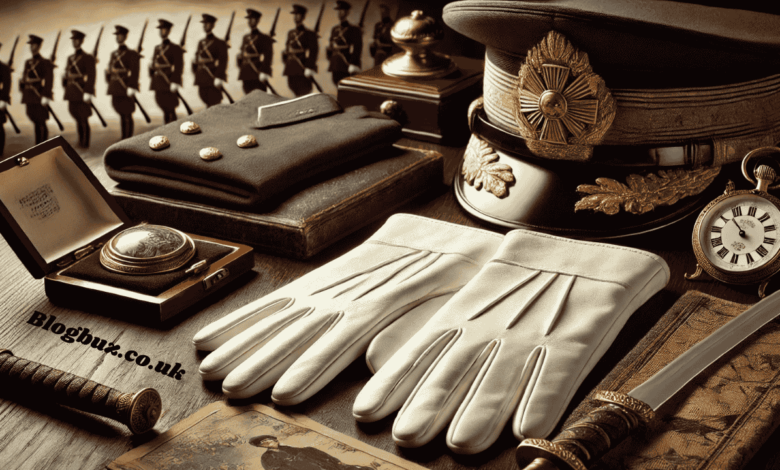Imperial Japanese Officer’s Gloves: Symbolism, History, and Legacy

The Imperial Japanese officer’s gloves hold a fascinating place in military history, representing much more than just functional apparel. These gloves, worn by the Imperial Japanese officer’s gloves, were potent symbols of rank, discipline, and the strict hierarchical culture of Japan’s military during the early 20th century. From their design and materials to their role in military tradition and ceremonial use, the gloves became an iconic part of the officer’s uniform. This article delves into these gloves’ history, cultural significance, and practical uses, providing a comprehensive understanding of their role in the Imperial Japanese military.
A Brief Historical Context
The rise of Japan as a military power in the late 19th and early 20th centuries was marked by efforts to modernize its military structure. During the Meiji Restoration, Japan shifted from traditional samurai warfare to a Western-style military, adopting elements of European and American military uniforms, including gloves as a staple of officer attire. By World War II, the Imperial Japanese officer’s gloves had become integral to the officer’s uniform, symbolizing professionalism and authority.
Design and Materials of Imperial Japanese Officer’s Gloves
The design of these gloves was highly functional yet refined. Typically crafted from high-quality leather, the gloves were designed to withstand the rigors of military life while maintaining a formal appearance. Officers often led troops in harsh conditions, from Manchuria’s cold landscapes to Southeast Asia’s humid jungles. As a result, the gloves were ceremonial and offered practical protection from the elements.
Key Features
- Material: Leather was the primary material used in making the gloves, which were valued for their durability and flexibility. Some variations included wool or cotton linings to provide extra warmth in colder environments.
- Colour: Most gloves were white, beige, or brown. White gloves, in particular, symbolized purity, authority, and detachment from manual labour.
- Craftsmanship: These gloves were meticulously crafted, with reinforced stitching to ensure they could endure extended use. Some versions included decorative elements, such as silver or gold piping, particularly for higher-ranking officers.
Symbolism and Cultural Significance
In the Imperial Japanese military, uniforms were practical attire and symbols of rank and discipline. The gloves were a critical visual element that set officers apart from lower-ranking soldiers, who typically did not wear gloves. This distinction reinforced the hierarchical structure of the Japanese military, which was deeply influenced by the values of Bushido, the samurai code that emphasized loyalty, honour, and discipline.
Authority and Command
The white gloves of an Imperial Japanese officer were a powerful visual cue that conveyed authority. They were typically worn during formal occasions such as inspections, military parades, and ceremonies. The spotless condition of the gloves reflected the discipline and high standards expected of an officer. In battle, the clean white gloves symbolized an officer’s leadership role, directing soldiers rather than engaging in the physical labour of combat.
Detachment from Manual Labor
Another significant aspect of the gloves’ symbolism was the separation between officers and enlisted men. Officers in most militaries are traditionally not involved in manual labour, and the Imperial Japanese military was no different. The pristine white gloves served as a reminder of this division, underscoring the intellectual and strategic responsibilities of officers while the lower ranks handled the physical aspects of warfare.
Connection to Bushido
The samurai’s values continued influencing the Japanese military long after the feudal era. The gloves represented a continuation of these values, emphasizing honour, duty, and respect for tradition. The emphasis on maintaining the gloves in immaculate condition reflected the officer’s internal discipline and adherence to these ancient virtues.
Practical Uses in Military Life
Though symbolic, the gloves also served practical purposes during military campaigns. Officers needed a certain level of protection while leading troops in diverse environments, whether in freezing conditions during the invasion of China or in the sweltering heat of the Pacific islands. The gloves helped protect the hands from abrasions, colds, and the wear and tear of handling weapons or equipment.
Protection in Combat
While not designed for heavy-duty combat, the gloves protected officers handling swords, firearms, or other military equipment. They helped prevent chafing and blisters, allowing officers to maintain their grip on weapons and tools during long marches or intense battles.
Ceremonial and Formal Use
Beyond their day-to-day military functions, the gloves were crucial for formal and ceremonial duties. Military parades, state ceremonies, and official gatherings required officers to appear immaculate, and the gloves were a vital part of this formal presentation. In particular, the gloves and the officer’s sword conveyed an image of honour, duty, and military excellence.
Evolution of the Imperial Japanese Officer’s Gloves
Over time, the design and materials used in these gloves evolved. Early versions of the gloves were relatively simple and focused on functionality. However, as Japan’s involvement in international conflicts grew, particularly during World War II, the gloves became more elaborate, with some designs incorporating improved materials, such as better linings for colder climates and more intricate stitching for durability.
Variations in Design
While white gloves were the most common, higher-ranking officers sometimes wore gloves made of finer materials or with additional embellishments like gold or silver piping. These variations helped signify rank and the officer’s position within the military hierarchy.
Legacy and Modern Perception
Today, Imperial Japanese officer’s gloves have become valuable collectables for military historians and enthusiasts. They offer a glimpse into the Imperial Japanese military’s highly disciplined and hierarchical nature. Collectors seek out well-preserved pairs of these gloves, especially those with unique features such as rank insignia or remarkable embroidery, which can significantly increase their historical value.
Cultural Impact
The image of an Imperial Japanese officer’s gloves has also persisted in popular culture. From war films to historical reenactments, these gloves continue to symbolize the rigid discipline and authoritarian nature of the Japanese military during World War II. They serve as a reminder of the powerful traditions and militaristic values that shaped Japan during its imperial expansion.
Conclusion
The Imperial Japanese officer’s gloves are more than just an accessory—they symbolize rank, authority, and military discipline. From their origins in Japan’s military modernization efforts to their use in World War II, the gloves played both practical and symbolic roles in shaping the image of the Japanese officer. Today, they remain a fascinating artefact of military history, reflecting the values and traditions of a bygone era. Whether viewed as part of a uniform or as a collectable item, these gloves continue to captivate historians and enthusiasts, offering valuable insights into the Imperial Japanese military.
FAQs: Imperial Japanese Officer’s Gloves
What were the Imperial Japanese officer’s gloves made of?
Imperial Japanese officer’s gloves were primarily made from high-quality leather, which provided durability and flexibility. Some variations included wool or cotton linings for extra warmth, especially in colder climates. The leather gloves were typically white, beige, or brown, signifying formality and rank.
What was the significance of white gloves in the Imperial Japanese military?
White gloves worn by Imperial Japanese officers symbolized authority, discipline, and purity. They visually represented the officer’s rank and separation from the manual labour performed by lower-ranking soldiers. These gloves reinforced the military’s hierarchical structure, reflecting the officer’s leadership role.
Were the gloves used during combat or only for ceremonial purposes?
While the Imperial Japanese officer’s gloves were often associated with formal and ceremonial occasions such as parades, inspections, and military ceremonies, they also had practical uses in combat. The gloves protected against the elements, such as cold or rough terrain, and helped prevent chafing when handling weapons or equipment.
Did all Imperial Japanese officers wear the same type of gloves?
No, there were variations in the gloves based on rank and occasion. Higher-ranking officers often wore gloves made from more luxurious materials or with decorative features such as gold or silver piping. However, white gloves remained the most common and symbolic of authority for all officers.
How were the gloves preserved during military campaigns?
Officers took great care to maintain their gloves, especially during formal events. The gloves were crafted to be durable, allowing for extended wear without quickly deteriorating. However, during active military campaigns, the gloves likely experienced wear and tear, though their preservation remained important as they maintained the officer’s disciplined appearance.
You May Also Read: The Legacy of the Honngen Civil War Sword: A Deep Dive into Historical Craftsmanship




